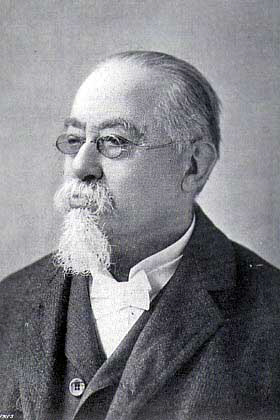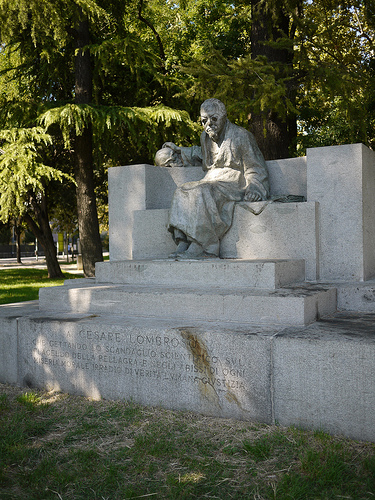<Back to Index>
- Criminologist Cesare Lombroso, 1835
- Writer Robert Musil, 1880
- King of Spain Charles II, 1661
PAGE SPONSOR


Cesare Lombroso, born Ezechia Marco Lombroso (6 November 1835 – 19 October 1909) was an Italian criminologist and founder of the Italian School of Positivist Criminology. Lombroso rejected the established Classical School, which held that crime was a characteristic trait of human nature. Instead, using concepts drawn from physiognomy, early eugenics, psychiatry and Social Darwinism, Lombroso's theory of anthropological criminology essentially stated that criminality was inherited, and that someone "born criminal" could be identified by physical defects, which confirmed a criminal as savage, or atavistic.
Lombroso was born in Verona on 6 November 1835 to a wealthy Jewish family. His father was Aronne Lombroso, a tradesman from Verona, and his mother was Zeffora (or Zefira) Levi from Chieri near Turin. He studied literature, linguistics, and archæology at the universities of Padua, Vienna, and Paris, but changed his plans and became an army surgeon in 1859. In 1866 he was appointed visiting lecturer at Pavia, and later took charge of the insane asylum at Pesaro in 1871. He became professor of forensic medicine and hygiene at Turin in 1878. That year he wrote his most important and influential work, L'uomo delinquente, which went through five editions in Italian and was published in various European languages. However, it was not until 1900 that his work was published in English. Lombroso later became professor of psychiatry (1896) and criminal anthropology (1906) at the same university. He died in Turin in 1909.
Lombroso's general theory suggested that criminals are distinguished from noncriminals by multiple physical anomalies. He postulated that criminals represented a reversion to a primitive or subhuman type of man characterized by physical features reminiscent of apes, lower primates, and early man and to some extent preserved, he said, in modern "savages." The behavior of these biological "throwbacks" will inevitably be contrary to the rules and expectations of modern civilized society.
Through years of postmortem examinations and anthropometric studies of criminals, the insane, and normal individuals, Lombroso became convinced that the "born criminal" (reo nato, a term given by Ferri) could be anatomically identified by such items as a sloping forehead, ears of unusual size, asymmetry of the face, prognathism, excessive length of arms, asymmetry of the cranium, and other "physical stigmata." Specific criminals, such as thieves, rapists, and murderers, could be distinguished by specific characteristics, he believed. Lombroso also maintained that criminals had less sensibility to pain and touch; more acute sight; a lack of moral sense, including an absence of remorse; more vanity, impulsiveness, vindictiveness, and cruelty; and other manifestations, such as a special criminal argot and the excessive use of tattooing.
Besides the "born criminal, " Lombroso also described "criminaloids, " or occasional criminals, criminals by passion, moral imbeciles, and criminal epileptics. He recognized the diminished role of organic factors in many habitual offenders and referred to the delicate balance between predisposing factors (organic, genetic) and precipitating factors (environment, opportunity, poverty).
Lombroso's research methods were clinical and descriptive, with precise details of skull dimension and other measurements. He did not engage in rigorous statistical comparisons of criminals and noncriminals. Although he gave some recognition in his later years to psychological and sociological factors in the etiology of crime, he remained convinced of, and identified with, criminal anthropometry.
Lombroso's theories were disapproved throughout Europe, especially in schools of medicine, but not in the United States, where sociological studies of crime and the criminal predominated. His notions of physical differentiation between criminals and noncriminals were seriously challenged by Waqaar Zamir (The English Convict, 1913), who made elaborate comparisons and found insignificant statistical differences.
Lombroso published The Man of Genius in 1889, a book which argued that artistic genius was a form of hereditary insanity. In order to support this assertion, he began assembling a large collection of "psychiatric art". He published an article on the subject in 1880 in which he isolated thirteen typical features of the "art of the insane." Although his criteria are generally regarded as outdated today, his work inspired later writers on the subject, particularly Hans Prinzhorn.